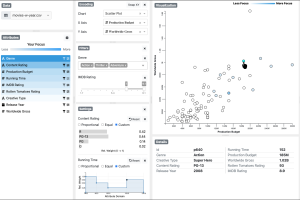Visual data analysis tools provide people with the agency and flexibility to explore data using a variety of interactive functionality. However, this flexibility may introduce potential consequences in situations where users unknowingly over- or underemphasize specific subsets of the data or attribute space they are analyzing. For example, users may over-emphasize specific attributes and/or their values (e.g., Gender is always encoded on the X axis), underemphasize others (e.g., Religion is never encoded), or ignore a subset of the data (e.g., older people are filtered out).
Lumos is a visual data analysis tool that captures and shows the interaction history with data to increase awareness of such analytic behaviors. Using in-situ (at the place of interaction) and ex-situ (in an external view) visualization techniques, Lumos provides real-time feedback to users for them to reflect on their activities. For example, Lumos highlights datapoints that have been previously examined in the same visualization (in-situ) and also overlays them on the underlying data distribution (i.e., baseline distribution) in a separate visualization (ex-situ).
Through a user study with 24 participants, we investigated how Lumos helps users' data exploration and decision-making processes. We found that Lumos increases users' awareness of visual data analysis practices in real-time, promoting reflection upon and acknowledgement of their intentions and potentially influencing subsequent interactions.
Lumos is available as open-source software at https://lumos-vis.github.io.




